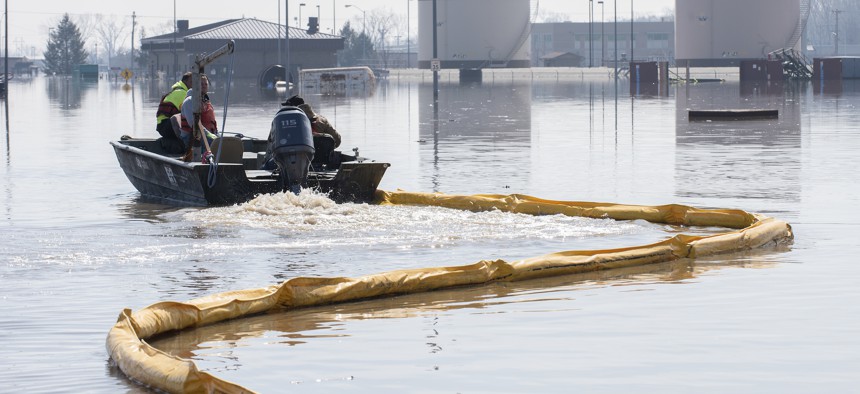
Contractors deploy a spill containment boom around the Offutt Air Force Base fuel storage area after flooding on March 18, 2019. U.S. Air Force / Delanie Stafford / 55th Wing Public Affairs
House cuts to Pentagon climate-resilience plans weaken the military
As weather grows harsher, hardening bases and gear is investment in capability.
In 1274, the Asian superpower known as the Mongol Empire sought to conquer its island neighbor Japan, but its invasion fleet was devastated by an enormous typhoon. Stubbornly, it rebuilt its invasion force and in 1281 tried the same thing, again during typhoon season. The second fleet was destroyed by a similar storm, thwarting Mongol plans for conquest. The latter invasion fleet was the largest in history until the D-Day invasion of Nazi-occupied France, which General Eisenhower prudently postponed when dangerous storms were forecast. The lesson? Weather—and climate—matter in war.
Today, any military commander would tell you that meteorological conditions can shape an operation’s outcome. Success comes when one takes weather seriously and plans for it.
More recently, U.S. military installations have undergone billions of dollars of damage from hurricanes and flooding exacerbated by a changing climate. In only the past five years, one can point to over $10 billion in damage at installations such as Tyndall AFB, Pensacola NAS and Key West NAS in Florida; Camp Lejeune and MCAS Cherry Point in North Carolina, and Offutt AFB in Nebraska. Recovery at these installations is taking years, underscoring the direct impact of climate change on military capability.
A changing climate drives both an evolution in the weather for which a military must prepare and shocks to the global political environment. Beginning under the George W. Bush administration, the intelligence community has warned that climate change will increase food insecurity, water scarcity and migration, driving global instability that undermines American interests. Even under the Trump administration, which was famously skeptical of climate change, Defense Secretary Jim Mattis characterized climate change as a “driver of instability” and committed to ensuring the department was “prepared to address the effects of a changing climate on our threat assessments, resources and readiness.” While the Biden administration’s Defense Department has been more explicit about linking specific programs to climate risks, the difference across administrations is one of degree and emphasis, not character. Resilience is resilience, whether you associate it with climate or not.
Eliminating the consideration of any risk that affects capability creates a blind spot—a weakness. As the increasing effects of a changing climate impose themselves upon both military capability and geopolitical stability, omitting them from analysis and preparation results in flawed analysis, unanticipated consequences, and a less ready force.
For the last two years, the Pentagon has included a report with its budget request that outlines which investments it believes will “mitigate climate risk.” This year’s budget request included $5.1 billion of such investments. The House Appropriations Committee objected to this report, labeling it as “disingenuous” to associate billions of dollars of defense programs with what it perceived to be a political climate agenda.
As a result, the committee cut hundreds of millions of dollars from the budget request in its version of the Fiscal Year 2024 Defense Appropriations Act. They cut funding for installations to plan for and adapt to emerging climate hazards. They also targeted programs that use emerging technologies in aircraft design and hybrid vehicles to increase efficiency and reduce logistics burdens. In other words, they had their own blind spot—that anything invoking climate must somehow be political—and therefore imposed a weakness on a military attempting to increase resilience and efficiency.
Perhaps the new program that is easiest to mischaracterize is the Army’s exploration of hybrid and battery technologies for new ground vehicles. Opponents invoke images of electric tanks, stuck on the battlefield, waiting to charge. While it’s true that there’s no charging station on the battlefield, there’s no gas station there either. The U.S. military brings its logistics with it. It’s worth remembering that attacks on fuel convoys accounted for many of the American deaths in Iraq and Afghanistan. Therefore, pragmatic exploration by the Army of how it can save those lives by using hybrid-electric engines should not be diminished by caricature. Moreover, battery-powered vehicles offer tactical advantages by eliminating the noise and heat signatures of gas-powered engines. If the Army can reduce its logistics burden and save soldiers’ lives by incorporating hybrid and battery-powered engines into appropriate warfighting systems, it should do so.
At the same time, environmental advocates should recognize—as the Defense Department does—that the primary driver for any of the requests labeled as climate investments is improved military capability. Some are focused on installation resilience to extreme weather, flooding or wildfires. Others are focused on efficiency, cost savings and reducing logistics requirements. The administration should not paint these efforts as driven by environmental goals any more than opponents should, even when the investments do result in reduced emissions. These climate investments are, first and foremost, investments in military capability.
In the end, leaders across the government should acknowledge that climate change affects our military and the environment in which it operates. We should prepare for our future with the clear-eyed perspective of General Eisenhower and recognize the climate shapes the battlespace and must be part of the plan.
John Conger is Director Emeritus of the Center for Climate and Security and former Principal Deputy Under Secretary of Defense (Comptroller).




